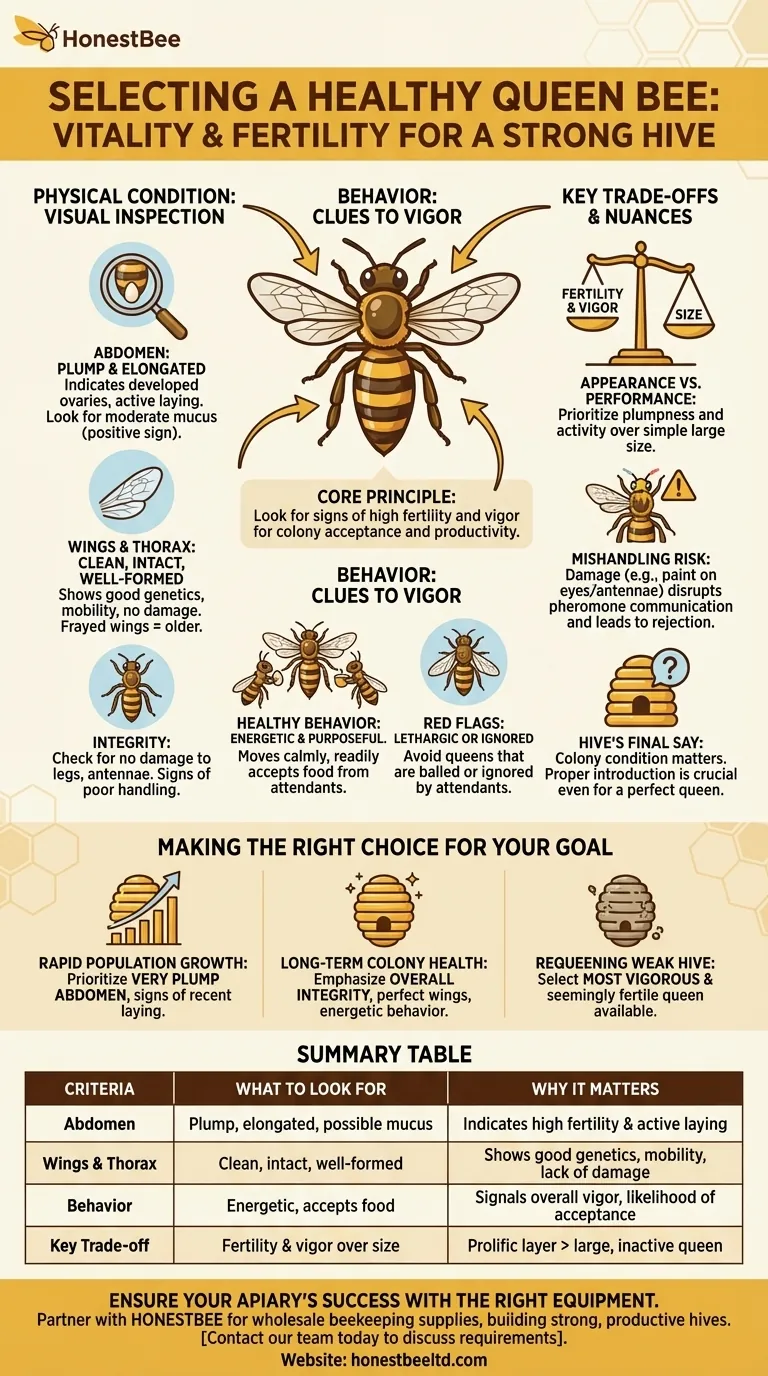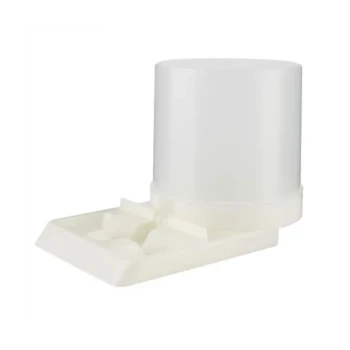To select a healthy queen bee, you must visually inspect her for specific signs of vitality and fertility. A healthy queen should possess a plump, elongated abdomen, a well-formed thorax, and clean, undamaged wings. Her behavior is also critical; she should move with purpose and readily accept food from the attendant bees in her cage.
The core principle of queen selection is to identify a queen whose physical condition and behavior signal high fertility and vigor. This is the single best predictor of her ability to be accepted by the colony and to build a strong, productive hive.

Assessing the Queen's Physical Condition
A visual inspection is your primary tool for evaluating a potential queen. Each part of her body offers clues to her health, age, and mating status.
The Abdomen: A Sign of Fertility
A queen's primary function is egg-laying, and her abdomen is the most direct indicator of this capability. Look for a plump and elongated abdomen, which suggests her ovaries are well-developed and she is either actively laying or prepared to do so.
You may also observe moderate mucus around her genital area. This is a positive sign, indicating she has been laying eggs very recently.
Thorax and Wings: Indicators of Mobility and Integrity
The thorax, the middle section of her body, should be robust and well-formed, supporting strong legs and wings.
Pay close attention to her wings. They should be clean, intact, and well-formed. Frayed or tattered wings can be a sign of an older queen, while any damage could impede her movement within the hive.
Behavior: Clues to Vigor
A healthy queen should appear calm but energetic. Watch how she moves within her cage and interacts with the attendant worker bees.
She should readily eat provided food and be actively tended to by the workers. A lethargic queen, or one that is being ignored or balled by the attendants, is a significant red flag.
Understanding the Key Trade-offs
Selecting a queen isn't just a simple checklist. You are interpreting signs to predict future performance, and it's important to understand the nuances.
Appearance vs. Performance
While a large, "beautiful" queen is appealing, size alone does not guarantee performance. Prioritize signs of fertility and vigor (plump abdomen, active behavior) over simple size. A slightly smaller queen who is a prolific layer is far more valuable than a large one who is not.
The Risk of Mishandling
A queen's health is delicate. Any damage she sustains can lead to her rejection by the hive. As noted when marking queens, getting paint on her antennae or eyes can disrupt her ability to communicate via pheromones.
This principle applies to selection. Scrutinize her for any signs of physical damage to her legs, wings, or antennae, as this could indicate poor handling and compromise her acceptance.
The Hive's Final Say
Ultimately, the colony makes the final decision. You can select a physically perfect queen, but if the hive is not prepared correctly—for example, if it is not hopelessly queenless or has laying workers—the introduction may still fail.
Your selection of a healthy queen is the first and most critical step, but it must be followed by proper introduction technique.
Making the Right Choice for Your Colony
Your specific goal for the hive should guide your final assessment.
- If your primary focus is rapid population growth: Prioritize a queen with a very plump abdomen and clear signs of recent egg-laying.
- If your primary focus is long-term colony health: Emphasize overall physical integrity, including perfect wings and energetic behavior, as these suggest good genetics and longevity.
- If you are requeening a weak or struggling hive: Select the most vigorous and seemingly fertile queen available, as the colony's survival depends on her immediate performance.
Choosing the right queen is the most impactful decision you can make for the future of your colony.
Summary Table:
| Selection Criteria | What to Look For | Why It Matters |
|---|---|---|
| Abdomen | Plump, elongated, possible mucus | Indicates high fertility and active egg-laying |
| Wings & Thorax | Clean, intact, well-formed | Shows good genetics, mobility, and lack of damage |
| Behavior | Energetic movement, accepts food from attendants | Signals overall vigor and likelihood of acceptance |
| Key Trade-off | Fertility and vigor over simple size | A prolific layer is more valuable than a large, inactive queen |
Ensure your apiary's success with the right equipment. Selecting a healthy queen is just the first step. Partner with HONESTBEE for all your beekeeping supply needs. We provide commercial apiaries and distributors with high-quality, durable equipment through our wholesale operations, helping you build and maintain strong, productive hives. Contact our team today to discuss your requirements and get a quote.
Visual Guide

Related Products
- High Performance Plastic Queen Excluder for Beekeeping and Apiary Management
- Stainless Steel Beekeeping Queen Grafting Tool for Honey Bee Rearing
- Wooden Queen Bee Excluder for Beekeeping
- Premium Wood Framed Metal Wire Queen Bee Excluder
- Plastic Queen Bee Excluder for Bee Hive Wholesale
People Also Ask
- What impact does a queen excluder have on colony defensiveness? Control Hive Temperament for Safer Beekeeping
- What are the benefits of a queen excluder? Ensure Pure Honey & Simplify Hive Management
- How does a queen excluder affect honey storage? Maximize Clean Honey Yields in Your Hive
- Why don't all beekeepers use Queen Excluders? Balancing Honey Purity with Hive Productivity
- What happens if I don't use a queen excluder? Understand the impact on your honey harvest.



















